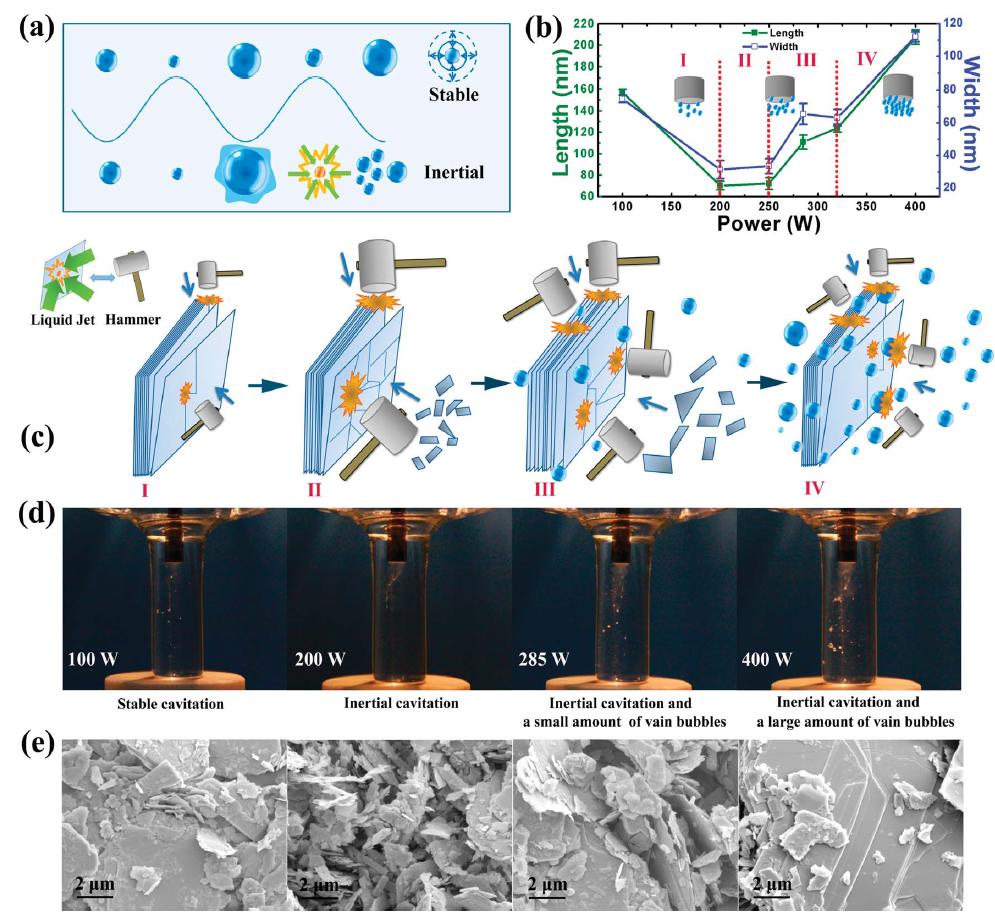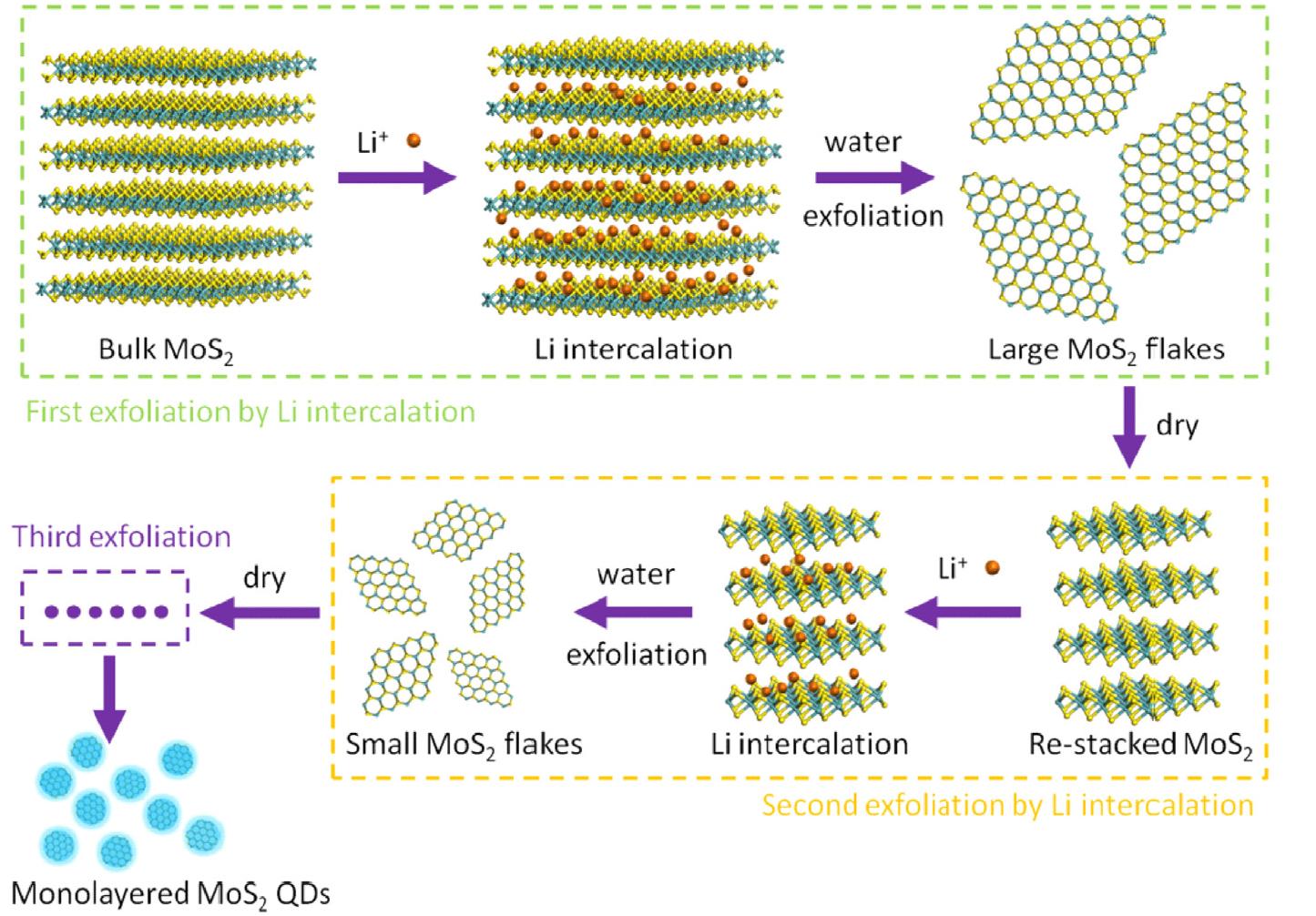博文
单层MoS2量子点的新颖合成方法
|||
单层MoS2量子点的新颖合成方法
钟伟
2017-10-18
MoS2纳米片作为一种重要的类石墨烯半导体二维材料,优异的物理、化学性质使其在众多领域具有广泛的潜在应用,因此引起人们极大的研究兴趣。在众多的制备方法中,超声液相剥离法操作简单,制备条件要求不高,而且剥离后能很好的保持材料原本的晶体结构,是最有希望实现大规模工业生产的一种制备方法。
超声液相剥离法是以MoS2粉体为原料,在合适的溶剂中,通过调节超声参数产生较强的空化效应,对块体MoS2进行剥离和分散从而获得MoS2纳米片的方法。我们采用南京先欧科技公司(ATPIO)生产的超声微波协同反应工作站(XO-SM50),研究了不同的超声功率对块体MoS2剥离程度及纳米片质量的影响(图1)。
Fig. 1Dispersions of MoS2 prepared with different ultrasonic power intensities. (a)UV-vis absorption spectra of MoS2 dispersions in NMP prepared with 100, 200,250, 285, 320, 350 and 400 W, respectively. In all the cases, the spectra areshown as measured absorbance, A, divided by cell length, l. Inset in (a) showsthe same spectra on a log–log scale. A straight dash line in the highwavelength region of this plot indicates a scattering background. (b) A/lsubtracted background for each sample of A excitonic peak is plotted as afunction of ultrasonic power. (c) Scattering exponent, n, as a function ofultrasonic power. Inset in (c) shows the variation of the position of Aexcitonic peaks (lA). (d) Image of the final dispersions after allowing them tostand for several weeks.
研究结果表明,随着超声功率的增加,悬浮液的浓度先增加,在320 W功率下浓度最高,超过320 W,浓度显著地下降。从100 W至250 W,纳米片的尺寸减小,200 W和250 W情况下,尺寸大多小于60 nm,且尺寸分布较均匀,285 W以后略有增加;350 W后,纳米片的平均横向尺寸的急剧增加。这种变化是由于空化泡引起的微射流敲击强度受到大量气泡散射的结果(图2)。
Fig. 2(a) Illustration of the two types of cavitation mechanism. (b) Mean flakelength and width (based on more than 300 randomly selected nanoflakes for eachsample) obtained at different ultrasonic power intensities. (c) Schematicrepresentation of the exfoliation procedure to obtain MoS2 nanoflakes in fourdistinct regions (I to IV). (d) Images of the acoustic cavitation bubbles inNMP solvent at different input powers. (e) SEM images of the sediment aftercentrifugation of 100, 200, 285 and 400 W samples.
为了获得单层量子点,我们采用Li离子插层法剥离MoS2,具体制备步骤如下:
1、取MoS2原粉放入圆底三口烧瓶中,滴入正己烷,烧瓶内通氩气保护。快速取丁基锂正己烷溶液放入圆底烧瓶内,将混合的MoS2原粉和丁基锂正己烷溶液静置2天,使锂充分插入MoS2层间,形成插层化合物LixMoS2。
2、真空抽滤插层的LixMoS2,并用正己烷多次清洗去除多余的丁基锂及有机残余物。
3、快速取出抽滤膜上的LixMoS2,使之与去离子水反应,液体中会有大量气泡产生,为LixMoS2与水反应生成的氢气。与水反应后,放入超声微波协同反应工作站(XO-SM50)中在180 W的功率下辅助超声1 h,即可获得单层的MoS2纳米片悬浮液。
图3单次Li离子插层剥离过程示意图
我们发现,初始的MoS2粉体尺寸在几微米至几十微米量级,经过一次插层剥离以后,得到的纳米片的尺寸在100-800 nm之间,尺寸明显减小,因此,如果将一次剥离的纳米片干燥重堆积后进行再次剥离,重复几次,最终即可以得到纳米级量子点。
干燥后重堆积的MoS2纳米片重复上面的步骤进行第二次、第三次Li离子插层剥离,如图4所示。最终得到平均粒径3 nm,粒径分布窄且为单层的MoS2量子点。
Fig. 4.Schematic illustration of the preparation of monolayer MoS2QDs using multipleexfoliation with Li intercalation.
相关研究工作成果,详见以下论文:
1. “Effects of ultrasonic cavitationintensity on the efficient liquid-exfoliation of MoS2 nanosheets” W. Qiao, S.M.Yan, X.M. He, X.Y. Song, Z.W. Li, X. Zhang, W. Zhong*, You-Wei Du, RSC Advances 4 (92), 50981-50987(2014)
2. “Enhancement of magnetism bystructural phase transition in MoS2”, S. M. Yan, W. Qiao, X.M. He, X.B. Guo, L.Xi, W. Zhong*, Y. W. Du, Appl. Phys. Lett., 106 (1), 012408(2015)
3. “Luminescent monolayer MoS2quantumdots produced by multi-exfoliation based on lithium intercalation”, W. Qiao,S.M. Yan, X.Y. Song, X. Zhang, X.M. He, W.Zhong*, Y.W. Du, Applied Surface Science 395, 130-136(2015)
4. “Monolayer MoS2 quantum dots ascatalysts for efficient hydrogen evolution”, W. Qiao, S.M. Yan, X.Y. Song, X.Zhang, Y. Sun, X. Chen, W. Zhong*,Y.W. Du, RSC Advances 5, 97696-97701 (2015)
https://blog.sciencenet.cn/blog-39459-1081360.html
上一篇:MoS2基混合维范德瓦尔斯异质结的吸波性能研究
下一篇:一生师表今犹在,十分忠厚古来稀-- -- 纪念恩师张惠良教授
全部作者的精选博文
- • 我的物理,我的大学(75)
- • 又到基金评审时
- • 我的物理,我的大学(68)
- • 我的物理,我的大学(66)
- • 我的物理,我的大学(63)
- • 扶上马,送一程
全部作者的其他最新博文
全部精选博文导读
相关博文
- • AAA PCI -- 学者心声(Authorea 预印论文报道)
- • Building a DIKWP-TRIZ Software System (初学者版)
- • DIKWP-TRIZ: Semantic Blockchain and Semantic Communica(初学者版)
- • DIKWP-TRIZ in 3-No Problem and Artificial Consciousnes(初学者版)
- • Comparison Between DIKWP-TRIZ and TRIZ(初学者版)
- • DIKWP-TRIZ: Enpower AI/AC Innovation (初学者版)



